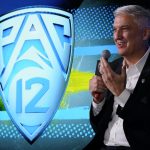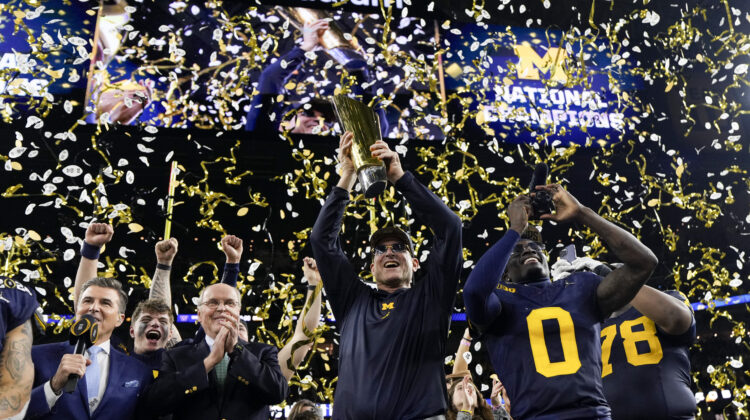The Hotline mailbag publishes weekly. Send questions to pac12hotline@
Please note: Some questions have been edited for clarity and brevity.
What’s the Over/Under on the number of years until the so-called college football Super League is formed and how many teams will it include? — @RockDawg3
Nine years.
Not six or eight. Not 10 or 12.
Nine.
That timeframe is the result of deep thinking about this very topic, mostly during the fall. But we’ll get to that piece momentarily.
First, let’s summarize the latest news for readers who might have missed it.
A collection of college sports leaders and sports media executives have quietly been formulating a plan to create college football’s Super League.
There had been whispers for months about the group, which is led by Len Perna, the chief executive of TurnkeyZRG whose search firm helped place many of the key leaders in college sports.
As reported by The Athletic earlier this week, Perna and his pals have proposed an 80-team league that would, like European soccer, feature promotion and relegation.
The schools in the Power Five, including Washington State and Oregon State, would be permanent members split into 10-team divisions. Schools in the Group of Five would also be involved.
The 16-team playoff would feature the division winners and wild cards. That’s right: No selection committee.
Here’s our view, in three easy-to-digest steps:
1. We commend Perna and his group for finally going public with their plan. Transparency is always better, especially when so many public universities are involved.
2. Their Super League concept stands no chance of materializing in the next few years.
3. Some type of Super League will arise at the end of the decade or in the early 2030s.
This is college football. The sport starts and ends with the SEC and Big Ten. Which means it really starts and ends with their media partners, ESPN and Fox, respectively.
The Super League would require the sport’s two grandmasters to rip up contracts with their conferences — contracts that were signed recently and smart business decisions.
Those deals include ESPN’s six-season extension of the College Football Playoff (2026-31), which carries a $1.3 billion annual price tag and is also a good deal for ESPN.
Why? Because none of the other networks offered a competitive bid, so ESPN grabbed the event at a relative discount.
The agreement reached last month is based on the existence of four power conferences.
The Super League needs eight divisions.
So you see the problem.
Unless ESPN is willing to void a favorable contract, the Super League is a non-starter.
In fact, the Super League will only materialize when it makes sense for ESPN and Fox — and when the media rights contracts with the individual conferences are aligned in a manner that allows for a tectonic shift in the structure of the sport.
The current arrangement creates inefficiency in supply — each conference has its own media deal — and that benefits the demand side (the networks).
As noted above, the Hotline gave the issue much consideration and published a vision for the future of the sport in late November, prior to the final Pac-12 football championship game.
In our vision, the Super League forms in the mid-2030s, as the SEC’s contract with ESPN is winding down.
And our Super League isn’t 80 teams. It’s only 24.
Why? Because 80 is an inefficient number for the networks. Why would ESPN or Fox (or Apple or Amazon) pay top dollar to broadcast Minnesota vs. Boston College and Cal vs. Texas Tech?
That’s not good business.
Good business is paying top dollar for Ohio State vs. Clemson and Oklahoma vs. USC and Notre Dame vs. Georgia — and only those caliber of games.
Maybe the networks could make the numbers work for a 32- or 40-team league. But not 80. Not even 60 or 70.
So as we see it, the Super League concept currently making the rounds doesn’t satisfy the needs of the only two entities that matter in college football, ESPN and Fox.
Only when the economics work for the networks will the revolution unfold.
If the college football Super League comes to fruition, can any semblance of the Pac-12 reunite for the other sports? — @round_mound34
The Hotline’s official position on this matter is clear: Basketball and the Olympic sports will eventually revert to the regional structure that has defined college sports until the past few years.
It’s possible that football becomes part of the process, especially if only 32 or 40 schools are involved in the Super League. The other 90 in the FBS would have no choice but to create regional leagues.
But a reconfigured Pac-12, Pac-16 or Pac-24 based on basketball and the Olympic sports is a given in the late 2020s or early 2030s, in our estimation.
Sending those teams across the country for conference play is inane and unsustainable.
How significant is the presence of Brian Rolapp, the NFL’s Chief Media and Business Officer, in the group pitching the college football Super League? — @KevinGH158627
We don’t view Rolapp’s presence as malicious with regard to this issue, but college football in general should be wary of NFL involvement on every level.
The NFL is a threat, folks — perhaps not an existential threat, because college football provides a regulated labor pipeline. But it absolutely threatens to limit the success of college football over the long haul.
The latest evidence came quite recently, in fact, when the NFL announced it would play two games on Christmas Day in 2024.
Christmas Day is a Wednesday.
It’s abundantly clear to the Hotline that the NFL is coming for every premium broadcast window in captivity. It might take a few years for its lawyers to circumvent the Sports Broadcasting Act that protects college and high school football in the fall. But eventually, it will attempt to gain complete and total domination.
And that’s not good for college football.
Has it been a mistake for the ‘Pac-2’ schools to look to the Mountain West for a possible merger, especially with the buyout window? Wouldn’t they be better off looking at Big Sky teams? — @Moneyline_RAY
We don’t see that as a viable option, for several reasons, including:
— The Big Sky has shown no interest in competing at the FBS level. Remember, the cost structure soars when schools move up because of the increased scholarship requirements (from 63 to 85).
— The Big Sky schools don’t carry enough media value to make a partnership worthwhile for Washington State and Oregon State. Granted, the Mountain West isn’t a ratings machine. But it has some value to the networks. The Big Sky has none.
Also, there’s no evidence Washington State and Oregon State have erred in pursuing a merger or reverse merger with the Mountain West. They haven’t made a move yet for 2026 and beyond — and probably won’t for another year.
The ‘Pac-2’ schools need to remain as flexible as possible for as long as possible to allow the chaos around the country to play out.
Would the Big 12 and ACC actually have been better off in the new College Football Playoff contract if the Pac-12 had survived intact? Would that have provided more counter-balance to the Big Ten and SEC’s demands? — @cougsguy06
Absolutely.
That’s the irony in all this: The breakup of the Pac-12 accelerated the consolidation of power by the SEC and Big Ten and the marginalization of the ACC and Big 12.
The Big 12, in particular, worked to destabilize the Pac-12 and pry loose the Four Corners schools because it (understandably) viewed realignment from a strength-in-numbers standpoint.
But if the 10 schools had stayed together in the Pac-12 and added San Diego State and SMU, the conference structure would not have tilted to the Power Two to the degree that it has.
The SEC and Big Ten were going to be the lead dogs, for sure. But there would have been some measure of balance.
Now, there is none.
Can you expand on the issues with the Washington State and Oregon State basketball programs moving into the West Coast Conference? Isn’t the goal just to make it to the NCAA Tournament? It seems the path would be easier in the WCC. — @brycetacoma
It seems that way, except for this: There are fewer at-large spots available in the WCC.
If the Cougars and Beavers don’t earn the conference’s automatic bid, which requires beating Gonzaga and/or Saint Mary’s on a neutral court, their paths to March Madness are limited.
Collectively, the WCC schools don’t play rigorous enough schedules to generate the resumes necessary to gain broad access to the at-large pool.
If the WCC receives one at-large bid, it’s a successful season.
I’m not sure Washington State and Oregon State are capable of regularly expanding that number given the scheduling challenges they are sure to face.
Any truth to the rumor that Arizona’s departing president, Robert Robbins, demanded the Big 12 not take WSU and OSU? — @Smittytheclownn
The Hotline has been privy to dozens of rumors over the past 18 months. That isn’t one of them.
Washington State and Oregon State simply didn’t make sense for the Big 12. They didn’t add security — the Four Corners schools took care of that — and they didn’t add value to the conference or its media partners (ESPN and Fox).
Put another way: If enough of the existing schools viewed the Cougars and Beavers as additive, they would have been added — regardless of Robbins’ position.
Could an enterprising ‘Pac-2’ coach pick up all the Stanford players in the transfer portal, hire Jerod Haase as an assistant, and have success in the WCC? — @LeadfootBeav
If Haase wanted to become an assistant at the WCC level, perhaps. We have no idea if that’s the case.
But the former Stanford players who have entered the portal are interested in NIL money just like everyone else. Would the Cougars and Beavers have the wherewithal? We don’t know about that matter, either.
Our suspicion is that a few of them return to Stanford.
Are you going to switch your coverage to the ACC next year? — @DC_SnDvl
Is this a Big 12 mailbag, a Big Ten mailbag or a ‘Pac-2’ mailbag? — @tecasey
Yes, yes and yes.
Also, yes.
We will cover the remaining and departing Pac-12 schools, and the issues that matter to them, regardless of their conference affiliation.
We’ll continue to report on news at the conference level, on the field, on the court and in court, if such situations arise.
College football (and basketball) is all interconnected at the 40,000-foot level.
A decision made by the Big Ten or SEC will have ramifications for the Big 12 and ACC, along with the ‘Pac-2’ and the Mountain West.
We aren’t going anywhere and, in fact, believe our role serving readers will be more important than ever in the next few years.
*** Send suggestions, comments and tips (confidentiality guaranteed) to pac12hotline@bayareanewsgroup.
*** Follow me on Twitter/X: @WilnerHotline
*** Pac-12 Hotline is not endorsed or sponsored by the Pac-12 Conference, and the views expressed herein do not necessarily reflect the views of the Conference.
Related posts:

Arizona guard Cedric Henderson Jr. (45) shoots against Stanford forward Brandon Angel (23) during the second half of an NCAA college basketball game Saturday, Feb. 11, 2023, in Stanford, Calif. (AP Photo/Josie Lepe)
Pac-12 rewind: Stanford stuns Arizona, UCLA thumps Oregon, ASU sweeps the Bay Area and more
(AP Photo/Ralph Freso, File)
Pac-12 media rights negotiations: Process nears completion as survival odds remain unchanged Hotline mailbag: The problem with partial shares for Oregon and UW (in the Big Ten), pondering Tulane and Rice, a Pac-8 and more
Hotline mailbag: The problem with partial shares for Oregon and UW (in the Big Ten), pondering Tulane and Rice, a Pac-8 and more 
(AP Photo/Marcio Jose Sanchez)
Hotline mailbag: ‘Worst-case scenario’ for the Pac-12, outlook for Oregon and UW, valuation rumors, expansion candidates and more
